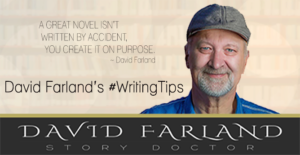Until 2012, I was a pantser. Truth be told, I still write short fiction without a plan sometimes, but I’ve been fully converted over to outlining. It’s a long story, but it’s worth the effort. The very first novel I wrote, RUNS IN THE FAMILY, took me 18 months to write. Without a roadmap, I would write all the little ideas and delete troves of words before latching onto another idea and doing the same thing over and over again. It was a slog and I hardly remember finishing it. When I had the idea that became my debut novel SLEEPER PROTOCOL, I vowed that I wouldn’t do that whole awful process again. I determined that I was going to figure out how to write a novel. I’ll cut off some of the story here, but a book on screenwriting changed the way that I write. That book was “My Story Can Beat Up Your Story” by Jeffrey Alan Schecter. It’s a quick, easy read that gives you insights into character development, story pacing, and a structure that resonates with your reader.
Schecter’s book impressed the folks at Mariner Software enough that they built a screenwriting program called Contour that follows his method to the letter. When I found out about Contour, I quickly downloaded the free demo. From there, I ended up purchasing the program. It’s a part of my pre-writing process, which is the theme of the month, so let me break down how I get ready to write a novel.
Let’s say I have an idea already pretty formed in my head. Chances are that I’ve started gathering some notes on that idea in a notebook (yes, I have a notebook problem – there are never enough). I take that pretty formed idea in my head and start to make sure I can craft it into some of the key notions that Schecter teaches about character development. The takeaway here is that without good characters, your story doesn’t live to tell the tale. Forget to develop your protagonist and your book never reaches the end of Act One because there’s nothing to change them. Fail to develop a solid antagonist and your story dies in Act Two. By building the character development first, even before I start the plotting pieces and exercises, I have a solid idea of where the story is going to go based on the goals of my characters. From there, I go through Contour’s beats and guide sheets to develop a “straw” outline – that’s my first pass entirely through Contour. I come back and add more detail to the areas that need it – thanks to big text boxes and the like. Once I’ve done that, it’s time to open Scrivener, my writing software.
Once in Scrivener, I use what’s in Contour to help flesh out a basic structure. I create the building blocks in various ways – either folders and chapters for scenes, the cork board function for random thoughts or unplaced ideas, and any references I need to consult as I write. With the data from Contour about specific plot points, character goals, and what the characters need to discover/solve/act upon, by the time I’ve laid out my pre-writing, I have a serious amount of data already in the program ready for me to use. Yes, it seems like a lot of work, but for me it’s better than trying to handle those dozens of notebooks and pieces of scratch paper. If I take the time to enter the ideas in Contour, it asks the questions for me and my answers further flesh out the plot. From there, writing is relatively easy.
How easy? At this point, I’ve invested several hours in building out Contour and laying out Scrivener the way I want it to. For me, the end result is that I write faster. Remember RUNS IN THE FAMILY? Eighteen months from start to finish? With the method I laid out above, I wrote SLEEPER PROTOCOL in seven weeks. I wrote the recently published sequel VENDETTA PROTOCOL in about nine weeks. It’s a much faster process when I know the route that I’m going to take. By laying out the entire novel, if a character decides to do something differently that I want them to, I can let that play out a little and still have a clear ending in mind. I can adjust things as I go, which is much easier than stopping and starting all over. With a full outline, I know where I have to get back to, and it makes a difference.
No two methods are the same, though. You have to figure out what works for you. For me, that intense planning and note taking process leads to big changes with my speed and productivity, but it may not work for you. There are a million ways to write a novel, but they don’t all require any prewriting. They do require writing, so get to it.

